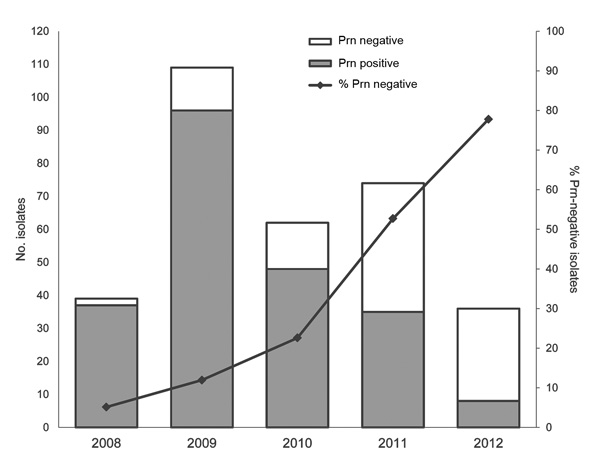Volume 20, Number 4—April 2014
Research
Rapid Increase in Pertactin-deficient Bordetella pertussisIsolates, Australia
Connie Lam, Sophie Octavia, Lawrence Ricafort, Vitali Sintchenko, Gwendolyn L. Gilbert, Nicholas Wood, Peter McIntyre, Helen Marshall, Nicole Guiso, Anthony D. Keil, Andrew Lawrence, Jenny Robson, Geoff Hogg, and Ruiting Lan
Author affiliations: University of New South Wales, Sydney, New South Wales, Australia (C. Lam. S. Octavia, L. Ricafort, R. Lan); University of Sydney, Sydney (V. Sintchenko, G.L. Gilbert); Westmead Hospital, Sydney, (V. Sintchenko, N. Wood, P. McIntyre); University of Adelaide, Adelaide, South Australia, Australia (H. Marshall); Institut Pasteur, Paris, France (N. Guiso); Princess Margaret Hospital for Children, Perth, Western Australia, Australia (A.D. Keil); Women’s and Children’s Hospital, Adelaide (A. Lawrence); Sullivan Nicolaides Pathology, Brisbane, Queensland, Australia (J. Robson); University of Melbourne, Parkville, Victoria, Australia (G. Hogg)
Figure 2

Figure 2. Number and percentage of pertactin (Prn)–negative Bordetella pertussis isolates in Australia, 2008–2012. During this period, 320 B. pertussis isolates obtained in New South Wales, Queensland, South Australia, Victoria, and Western Australia were identified as expressing prn or not expressing prn by using Western immunoblotting. The increasing percentage of prn-negative isolates each year during 2008–2012 was 5%, 12%, 23%, 53%, and 78% respectively. Data for individual states and years can be found in the Table. Gray bars indicate number of isolates expressing prn, and white bars indicate number of isolates not expressing prn. Error bars indicate 95% CIs.
